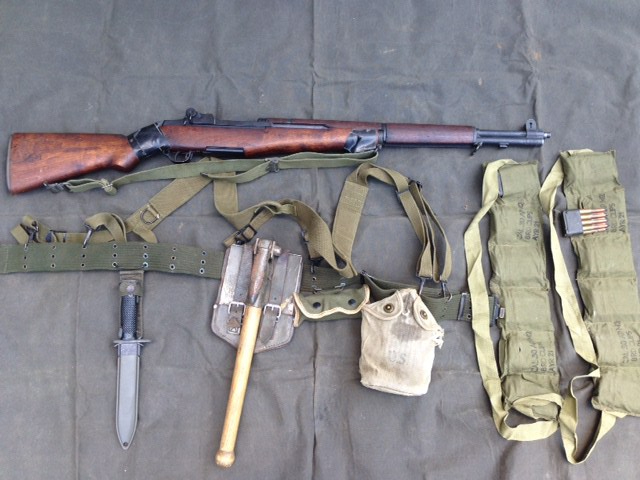One of my cousins recently found some letters written by my great- uncle, Warren. They were posted from Czechoslovakia, where he was fighting in the 97th Infantry Brigade during the Second World War. One of these was sent to two of his younger brothers, who were also in the army, preparing to go to the Pacific theater. In one of the letters, he passes on to his brothers some of the lessons he has learned in combat. Of particular interest is his advice concerning combat loads. Here is an excerpt:
Say when the Sgt. tells you that to wear the packs and so on you can figure to yourself that he is wrong but don’t tell him yourself it may get you in trouble. Over here when you are in action all you wear is your belt with canteen, bayonet, shovel, first aid packet and rifle launcher sight if you have it. With that you have two bandoleers of ammunition plus three or four hand grenades. I have three rifle grenades because I have the launcher. All of this gets heavy as almost any pack you may wear except a full field with a horseshoe roll over it. Right at present I have twenty eight clips of ammo with me and it is darn nice to have that much. I don’t know what they wear in the south pacific but I would imagine about the same.
This description of his combat load piqued my interest. It is easy to find what the field manuals of the day told infantrymen to carry, but I don’t often see actual, original- source accounts. This is, of course, of special interest to me, because of the family connection. Therefore, I set out to recreate Uncle Warren’s combat load, as he describes it, as closely as possible, from things I had knocking about in the shed. Here is a picture of what it looked like.

Before I get the historians and reenactors upset, let me say there are more things wrong with this than are correct. The Bayonet is for an M14, the E-tool is Danish (I think), the belt and suspenders are wrong, etc. My purpose in this was not to create a museum display, but to get a rough estimate for what all of this would look like, and, more importantly, weigh.
In this photo, we have an M1 Garand rifle with cotton web sling, belt and suspenders, bayonet, E-tool, grenade launcher sight, canteen, and two bandoleers of ball ammunition. I would have expected him to carry two canteens, but he lists his canteen in the singular. As he is talking about cutting weight, I’ll assume this is not a mistake. He was also campaigning in April, so a single canteen may have been sufficient in the cool European spring.
The load, as shown, weighs 26 pounds.
Items not shown are the grenade launcher at 1.1 #, three rifle grenades at 1.5 # ea, hand grenades at 1.3 # ea, and first aid packet at .5 #. He mentions at the time of his writing, he has 28 clips instead of the 16 pictured. The extra 12, to make up the balance, would add 4.5 pounds.
This would bring the total to 41.3 pounds; as he notes, this is heavy enough; especially when you consider that I did not take into account the weight of clothing, boots and helmet.
Some thoughts on this: First, the problem of soldiers being weighted down with excess gear is not new. Estimates of WWII combat loads are much lighter than that of infantrymen today, but even then, they found it necessary to strip down to bare essentials in order to reduce weight.
Second, note what is not carried: No food (he writes a lot about being hungry), no second canteen, no blankets or sleeping bag, no tent, no rain gear. Yet, with everything he has stripped from his load, he is happy to have the extra ammunition, with all its weight.
Third: He was serving as line infantry in a settled area. Trucks were supposed to bring up food and supplies to the front regularly (in practice they often did not), and there were sometimes buildings the men could take shelter in.
Finally, his outfit were moving very fast, covering nineteen- plus miles a day on foot. You have to travel light if you are going to do that.
Uncle Warren was killed in action on May 2, 1945 the day after the letter sited here was posted.
If any historians or reenactors reading this have special knowledge on this subject, I would love to hear from you.